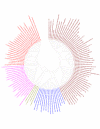Multilocus sequence typing method for identification and genotypic classification of pathogenic Leptospira species
- PMID: 17121682
- PMCID: PMC1664579
- DOI: 10.1186/1476-0711-5-28
Multilocus sequence typing method for identification and genotypic classification of pathogenic Leptospira species
Abstract
Background: Leptospira are the parasitic bacterial organisms associated with a broad range of mammalian hosts and are responsible for severe cases of human Leptospirosis. The epidemiology of leptospirosis is complex and dynamic. Multiple serovars have been identified, each adapted to one or more animal hosts. Adaptation is a dynamic process that changes the spatial and temporal distribution of serovars and clinical manifestations in different hosts. Serotyping based on repertoire of surface antigens is an ambiguous and artificial system of classification of leptospiral agents. Molecular typing methods for the identification of pathogenic leptospires up to individual genome species level have been highly sought after since the decipherment of whole genome sequences. Only a few resources exist for microbial genotypic data based on individual techniques such as Multiple Locus Sequence Typing (MLST), but unfortunately no such databases are existent for leptospires.
Results: We for the first time report development of a robust MLST method for genotyping of Leptospira. Genotyping based on DNA sequence identity of 4 housekeeping genes and 2 candidate genes was analyzed in a set of 120 strains including 41 reference strains representing different geographical areas and from different sources. Of the six selected genes, adk, icdA and secY were significantly more variable whereas the LipL32 and LipL41 coding genes and the rrs2 gene were moderately variable. The phylogenetic tree clustered the isolates according to the genome-based species.
Conclusion: The main advantages of MLST over other typing methods for leptospires include reproducibility, robustness, consistency and portability. The genetic relatedness of the leptospires can be better studied by the MLST approach and can be used for molecular epidemiological and evolutionary studies and population genetics.
Figures
References
-
- Kmety E, Dikken H. Classification of the species Leptospira interrogans and history of its serovars. University Press Groningen The Netherlands; 1993.
-
- Brenner DJ, Kaufmann AF, Sulzer KR, Steigerwalt AG, Rogers FC, Weyant RS. Further determination of DNA relatedness between serogroups and serovars in the family Leptospiraceae with a proposal for Leptospira alexanderi sp. nov. and four new Leptospira genomospecies. Int J Syst Bacteriol. 1999;49:839–858. - PubMed
-
- Ramadass P, Jarvis BDW, Corner RJ, Penny D, Marshall RB. Genetic characterization of pathogenic Leptospira species by DNA hybridization. Int J Syst Bacteriol. 1992;42:215–219. - PubMed
Publication types
MeSH terms
Substances
LinkOut - more resources
Full Text Sources
Miscellaneous


